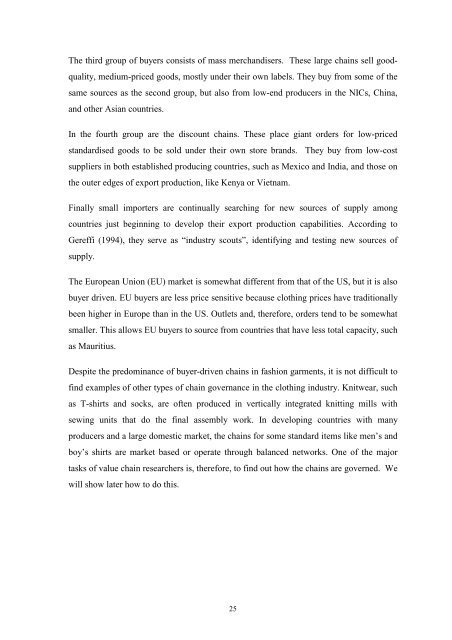McCormick+Schmitz Handbook for value chain research on - PACA
McCormick+Schmitz Handbook for value chain research on - PACA
McCormick+Schmitz Handbook for value chain research on - PACA
Create successful ePaper yourself
Turn your PDF publications into a flip-book with our unique Google optimized e-Paper software.
The third group of buyers c<strong>on</strong>sists of mass merchandisers. These large <str<strong>on</strong>g>chain</str<strong>on</strong>g>s sell goodquality,<br />
medium-priced goods, mostly under their own labels. They buy from some of the<br />
same sources as the sec<strong>on</strong>d group, but also from low-end producers in the NICs, China,<br />
and other Asian countries.<br />
In the fourth group are the discount <str<strong>on</strong>g>chain</str<strong>on</strong>g>s. These place giant orders <str<strong>on</strong>g>for</str<strong>on</strong>g> low-priced<br />
standardised goods to be sold under their own store brands. They buy from low-cost<br />
suppliers in both established producing countries, such as Mexico and India, and those <strong>on</strong><br />
the outer edges of export producti<strong>on</strong>, like Kenya or Vietnam.<br />
Finally small importers are c<strong>on</strong>tinually searching <str<strong>on</strong>g>for</str<strong>on</strong>g> new sources of supply am<strong>on</strong>g<br />
countries just beginning to develop their export producti<strong>on</strong> capabilities. According to<br />
Gereffi (1994), they serve as “industry scouts”, identifying and testing new sources of<br />
supply.<br />
The European Uni<strong>on</strong> (EU) market is somewhat different from that of the US, but it is also<br />
buyer driven. EU buyers are less price sensitive because clothing prices have traditi<strong>on</strong>ally<br />
been higher in Europe than in the US. Outlets and, there<str<strong>on</strong>g>for</str<strong>on</strong>g>e, orders tend to be somewhat<br />
smaller. This allows EU buyers to source from countries that have less total capacity, such<br />
as Mauritius.<br />
Despite the predominance of buyer-driven <str<strong>on</strong>g>chain</str<strong>on</strong>g>s in fashi<strong>on</strong> garments, it is not difficult to<br />
find examples of other types of <str<strong>on</strong>g>chain</str<strong>on</strong>g> governance in the clothing industry. Knitwear, such<br />
as T-shirts and socks, are often produced in vertically integrated knitting mills with<br />
sewing units that do the final assembly work. In developing countries with many<br />
producers and a large domestic market, the <str<strong>on</strong>g>chain</str<strong>on</strong>g>s <str<strong>on</strong>g>for</str<strong>on</strong>g> some standard items like men’s and<br />
boy’s shirts are market based or operate through balanced networks. One of the major<br />
tasks of <str<strong>on</strong>g>value</str<strong>on</strong>g> <str<strong>on</strong>g>chain</str<strong>on</strong>g> <str<strong>on</strong>g>research</str<strong>on</strong>g>ers is, there<str<strong>on</strong>g>for</str<strong>on</strong>g>e, to find out how the <str<strong>on</strong>g>chain</str<strong>on</strong>g>s are governed. We<br />
will show later how to do this.<br />
25














